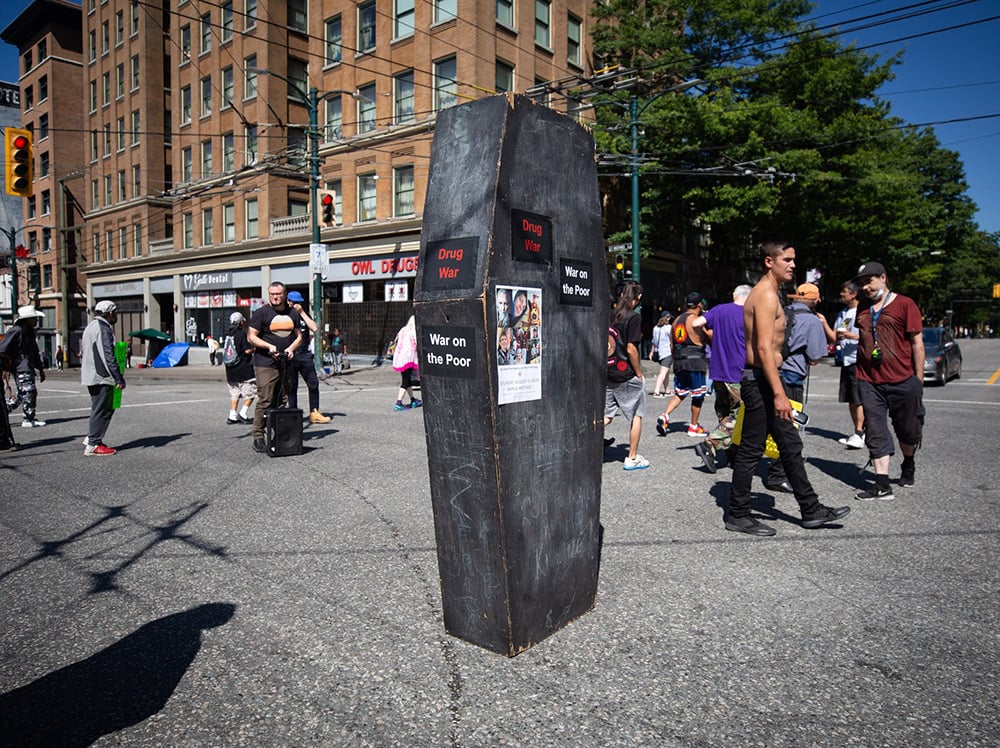Toxic drugs killed 2,224 people in British Columbia in 2021, the highest number ever, the BC Coroners Service reported today.
In November and December — the most deadly months on record with 210 and 215 people dead — an average of seven people died every day.
Despite government promises of action, deaths increased 26 per cent in 2021, as potent and unpredictable combinations of illicit street drugs increased and provincial efforts to expand prescribed safe supply and decriminalization stalled.
“After six years of this, it’s clear we’re not learning from these mistakes, and we’re wasting our mistakes and wasting our lessons and people are dying,” said Guy Felicella, a peer advisor at the BC Centre on Substance Use.
“It’s just so unacceptable.”
Deaths have increased steadily since March 2020, when pandemic closures limited access to overdose prevention services, isolated substance users and brought increasingly stronger and unpredictable substances.
Fentanyl contributed to an estimated 83 per cent of deaths in 2021, up from just five per cent in 2012. A recent study from the BC Centre for Disease Control suggested that a majority of substance users can no longer access heroin and use fentanyl instead, increasing their risk of overdose.
Carfentanil, an even more concentrated synthetic opioid, contributed to 187 deaths, compared to 66 in 2020.
Benzodiazepines, a class of depressants often prescribed to treat anxiety, have become more commonly mixed with other substances. They were present in one-quarter of opioid samples tested in Vancouver in September 2021.
“Benzo-dope” poses a unique set of challenges, increasing the likelihood of death.
In September 2020, Minister of Mental Health and Addictions Sheila Malcolmson said the province would expand prescribed safe supply options to separate people from the toxic drug supply.
The province also continued to expand overdose prevention sites, fund some new and refurbished treatment spaces and applied for federal permission to decriminalize personal possession of a very small amount of illicit substances in B.C.
The numbers show the response has failed, say critics.
“Our kids, and the ones that are dying, have no use for those beds, or those services,” said Leslie McBain, co-founder of advocacy group Moms Stop the Harm. She lost her son, Jordan Miller, to a fentanyl overdose in 2014 when he was 25.
“It’s not only too little what she’s actually doing, it’s too little of the right things.”
The safe supply measures, released in July, were also criticized by drug users and experts as too narrow to make a meaningful difference.
They required people to have a family doctor and a diagnosed substance-use disorder to access prescribed alternatives to street drugs. They also exclude wider access to pharmaceutical-grade heroin, which has had positive impacts for the less than 200 people who can access it in Vancouver.
“It is unbelievable there’s no appreciable action on safe supply... still when the death numbers are going to be worse than they’ve ever been,” said McBain. “It’s getting worse.”
McBain and Felicella said that barriers to access make the province’s safe supply effort meaningless.
“It would be game-changing if people could actually get it, but the reality is there are just so many barriers to it,” said Felicella, who in September 2020 expressed extreme optimism about the directive’s potential to save lives overnight.
But doctors are hesitant to prescribe safe supply, he noted, due to pressure from their profession and regulatory bodies recently addressed by Chief Coroner Lisa Lapointe in an interview.
Lapointe said in December the slow response to the toxic drug crisis will be a “stain on our province for decades to come.”
“Simply put, we are failing... This crisis is not going to turn itself around, this crisis needs some true intervention on a meaningful provincial scale.”
In a December interview with The Tyee, Malcolmson defended her government’s efforts to stop deaths.
“The fact that the drug toxicity increases are outpacing the ability of our health-care system to implement solutions and set up resources within health care is tragic, and something that just further reinforces our determination to do more,” she said.
Since overdose deaths were declared a public health emergency in April 2016, per capita deaths have more than doubled from 20.4 to 42.8 per 100,000 in 2021.
Toxic drugs are the leading cause of preventable death among 19 to 39-year-olds in B.C.
Vancouver Coastal and Northern Health are the hardest hit, where the death rate is now 49 and 48 per 100,000, respectively.
In May, the First Nations Health Authority reported that First Nations men and women in B.C. were dying at a rate more than 10 times their non-Indigenous peers in 2020.
McBain and Felicella expressed deep frustration with the little action taken by the province as more and more people are dying.
They both criticized the structure of Malcolmson’s ministry, which has little money or power to direct programs administered through the Ministry of Health.
“If she could implement safe supply, she would have done it,” said McBain.
With little indication the province will change course and no reason to believe the drug supply will become more predictable, Felicella and McBain said the number of people dying will only continue to grow.
“If it hasn’t impacted your family yet, it will,” said Felicella. “It will come and knock on your door.” ![]()
Read more: Health, Rights + Justice, BC Politics
















Tyee Commenting Guidelines
Comments that violate guidelines risk being deleted, and violations may result in a temporary or permanent user ban. Maintain the spirit of good conversation to stay in the discussion.
*Please note The Tyee is not a forum for spreading misinformation about COVID-19, denying its existence or minimizing its risk to public health.
Do:
Do not: